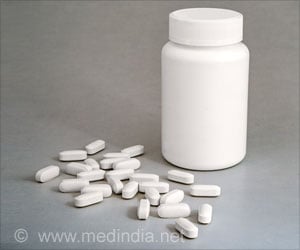Three commonly used nonsteroidal anti-inflammatory drugs, or NSAIDs, alter the activity of enzymes within cell membranes, discover researchers.

More positively, the researchers say, their work provides the basis for a test that drug developers can use to predict and perhaps avoid these side effects in new medicines they make. A summary of the results will be published online in the journal Cell Reports on Aug. 21.
"When drug designers think about possible sources of side effects, they tend to think about which proteins are similar to the protein they are targeting, and they make sure that the former are not affected by the drug," says Sinisa Urban, Ph.D., an associate professor of molecular biology and genetics at the Johns Hopkins University School of Medicine and a Howard Hughes Medical Institute investigator. "But our group has found that drugs that affect the cell membrane can alter the activity of proteins that are totally unrelated to the target."
Working with Syed Moin, then a postdoctoral fellow in his laboratory, Urban's project began as an investigation into the role of the cell membrane in the activity of a group of "cellular scissors" embedded within it, known as rhomboid proteases. When rhomboid proteases cut proteins, the split proteins are released from the membrane. From there, half a protein might go on to signal to another cell or both halves might end up being degraded to prevent further functioning. It all depends on the jobs of the specific proteins that are cut, which are known to play roles in everything from malaria to Parkinson's disease.
Urban says they had already learned that rhomboid proteases have an unusual way of "deciding" which proteins to cut: They look for those whose structures are unstable. Since some proteins are inherently more stable or less stable, rhomboid proteases have certain "protein clients" that are more or less likely to be cut.
Building on the fact that cell membranes provide some support to proteins embedded in them, Urban tried changing the physical properties of this "habitat" to see if alterations would change which proteins rhomboid proteases cut.
Advertisement
Aware that many drugs end up in the cell membrane, Urban assessed the effect of certain drugs on rhomboid proteases' ability to recognize their normal clients.
Advertisement
According to those same studies, some prescription-level NSAIDs, like flurbiprofen, approved for treating serious arthritis, make gamma-secretase less likely to cut APP at the wrong site, but how they do so is unclear.
If the drugs alter gamma-secretase activity by changing its habitat, the researchers thought they might have a similar effect on rhomboid proteases. So Urban treated the cells with flurbiprofen, indomethacin and sulindac at high but similar concentrations to those found in the blood of patients taking them at approved doses. Rhomboid proteases again cut clients they shouldn't, like APP and Delta, just as they had when treated with the membrane-altering chemicals.
When cells were treated with NSAIDS sold over-the-counter, like aspirin, ibuprofen and naproxen, however, the range of clients cut by rhomboid proteases increased only slightly, if at all.
To test the effect of the NSAIDs on cell membranes directly, Urban used an instrument that measures melting temperatures. Because membranes are composed primarily of fat molecules, heat can make them more fluid, like melting butter. In the same way that olive oil is a liquid at room temperature but shortening is a solid, the composition of molecules in the cell membrane can raise or lower the temperature at which it "melts." A lower melting temperature means a more flexible membrane, and the researchers found that the same prescription-level NSAIDs that lowered the membrane's melting temperature caused rhomboid proteases to cut nonclient proteins.
"It's possible that some of the side effects of NSAIDs are caused by their effect on the membrane and its enzymes," says Urban. "Our results are also a caution to drug developers trying to target new drugs to the membrane or hoping to increase the duration or dosage of already approved drugs. Throwing off the balance of the membrane has consequences."
One of the benefits of this study is that the researchers' method can be used to test new drugs for membrane-altering effects. "Now we can use rhomboid proteases as predictors of a drug's possible effects on the membrane and its enzymes," says Urban.
Source-Eurekalert












